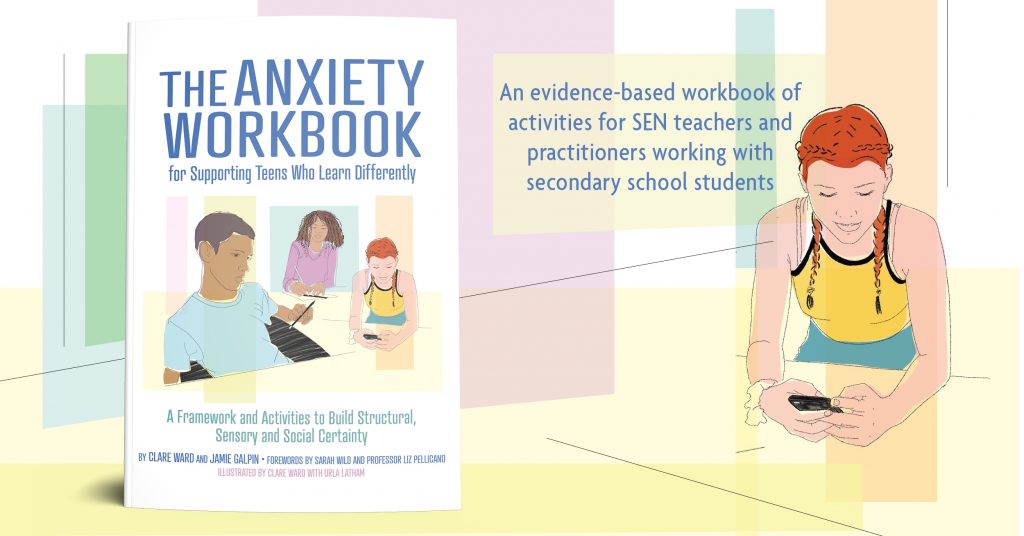Clare Ward & James Galpin explain their theory behind why uncertainty is often the root cause of anxiety for people universally, and especially for students with special educational needs. The Anxiety Workbook for Supporting Teens Who Learn Differently is a workbook filled with activities for teachers to use when helping to soothe anxiety.

What’s the book about?
It’s about the natural differences in thinking that, instead of dividing us, unify us all. It explains how all of us are striving for the same thing; certainty. In this context the book then invites readers to rethink anxiety and indeed all the difficulties we experience as being driven by uncertainty. What is different for each of us is simply the amount of uncertainty that we experience and our ability to tolerate it.
The teenage world is particularly uncertain. The familiar structure of your world is changing, your sense of self is in flux and social life is becoming more complex. The book addresses each of these three areas in turn. It sets out our simple 3S framework for building structural, sensory and social certainty, with clear examples and activities for how to do this.
The events of the last year have brought greater uncertainty to all our lives and provided a powerful reminder of how we really don’t like it.
We are predictavores; biological organisms trying to live our lives in the most energy efficient way we can. To do this we build models of the world. Webuild our models by finding patterns, making memories and connections. These models mean we can predict what we might experience and then prepare to manage it essentially, we see the world by predicting the world. The better our models the less unpredictable our world appears.
Imagine walking down the street and then tripping up.
Our model of ‘walking’ is usually a pretty good one. We wouldn’t usually expect to trip, this is a prediction error. It can make us, even if just momentarily, feel very uncomfortable. This small example shows how we don’t generally like these errors; they can make us feel deeply uncomfortable and the lasting impact will depend on our capacity to manage the uncertainty they bring.
Research on predictive processing, uncertainty and our own experience all led to the creation of our 3S framework. This version of the book is for learners in secondary schools, so the examples are most relevant to this group, but we believe you can apply this framework to any kind of psychological inflexibility, discomfort or distress.
What’s structural uncertainty?
Not knowing what’s coming up next in a lesson, or whether the teacher will set homework on the day that’s in my planner. Trying to follow instructions I find ambiguous. Struggling with a change in the timetable and wondering how long it will last. Having too much of someone else’s structure imposed on me, or not enough.
What’s sensory uncertainty?
Not being able to locate a strange new sound in the classroom and losing focus. Finding the canteen overwhelming every single day. Not knowing that the extreme discomfort I’m feeling is actually because I need the toilet. Feeling angry but actually being hungry. Not being able to predict how I might feel in different situations so being genuinely unable to answer the question – ‘Do you want to come with us?’
What’s social uncertainty?
Being unsure what ‘face’ my teacher is making – is she annoyed or confused? Unsure how someone else expects me to behave. Not being able to predict what someone might be interested in talking about. Feeling judged, misunderstood and unable to join in. Did she just ignore me? Is he laughing at me?
So what do we do when we feel this way?
We search for certainty – through knowledge or control.
There’s a whole lot of certainty in avoidance. If I don’t go/ speak /turn my camera on/ do the test, I can stay here with my own certainty, it puts me in total control. This approach can work in the immediate short term but will inevitably lead to greater uncertainty further down the line.
Teenagers do lots of other things too. Things that challenge and create uncertainty for us. They might talk to friends in lessons, tap objects on desks, argue their point excessively, ask repetitive questions, criticise others, appear to control friendships, appear to demand attention/ connection, self-harm, follow a restrictive diet or eat compulsively . This diverse range of behaviours could seem overwhelming to manage. Taking a step back we can see that they are all driven by a desperate search for structural, sensory and social certainty.
“Where’s the uncertainty?”
This fundamental question is always our starting point for support, it addresses our own uncertainty around causes of difficulties as well as helping us to support others. By rethinking special needs in this way we can recognise behaviours as being driven by an exaggerated need for control, a fraught attempt to wrestle back some certainty.
When designing appropriate support we will always look across all three of the S’s, Structure, Sensory, Social. We then identify which area of uncertainty might be causing the greatest difficulty and how we might all work together to first reduce uncertainty and then to increase someone’s capacity to manage it. We do this by giving young people more knowledge, understanding and agency (control), because one thing is for sure, the world is full of uncertainty.
Clare Ward is an independent Speech and Language Therapist specialising in social communication who consults to primary and secondary schools. James Galpin is a chartered Developmental Psychologist and is Head of Research at The Bridge London Trust and a Senior Teaching Fellow at the Institute of Education, UCL.